Subsistence fishing methods of Nicobari tribes using traditional knowledge
Krishi Vigyan Kendra-CARI, Car Nicobar, India
Krishi Vigyan Kendra-CARI, Car Nicobar, India
Central Agricultural Research Institute (CARI), Port Blair 744 101, Andaman and Nicobar Islands, India krishnanars@yahoo.com
Central Agricultural Research Institute (CARI), Port Blair 744 101, Andaman and Nicobar Islands, India
Department of Ocean Studies and Marine Biology, Pondicherry University, Port Blair 744 112, Andaman and Nicobar Islands, India pondiunisachin@gmail.com
Central Agricultural Research Institute (CARI), Port Blair 744 101, Andaman and Nicobar Islands, India
Abstract
Nicobarese are one of the six aboriginal tribes inhabiting Andaman and Nicobar Islands. They account for over 95% of the total tribal population in the islands and majority of them inhabit at Car Nicobar, which is the capital of Nicobar district and popularly called as Coconut Island. The Nicobari tribes are hunters and gatherers who use their indigenous knowledge for exploitation of marine fishery resources using locally available materials. The common fishing methods in vogue are tamatu (trap), thanam kak (spear with rope) chok/linreny kak (spear with rubber), kinyav (icthyotoxic seed), thakua kak (line), kel thakua kak (hand line), tamarotha thakua kak (long line), Hanak Inhal Kak (shore seine), Inruon thakua kak (troll line) and Inhal (gill net). The Nicobari tribes have inherited the skill for designing and operating these gears from their forefathers. This paper summarises the traditional knowledge existing and commonly practiced among the Nicobari tribes for exploitation of marine fish at Car Nicobar.
Keywords
Nicobari tribes, Indigenous knowledge, Fishing
Introduction
The Andaman and Nicobar islands lie in the eastern part of India in the southeast part of the Indian Ocean in the Bay of Bengal with an overall length of 700 km north to south and a geographic area of 8249 sq.km. There are 572 islands of which 38 are inhabited. It is home for six different tribal communities viz., the Great Andamanese, Onge, Jarawa, Sentinels, Shompen and the Nicobarese. Among these tribes, Nicobari and Shompen are restricted to Nicobar group of islands, while the rest are restricted to Andaman group of islands, who are essentially primitive and still gather their foods. These tribes practice fishing for food and survival purpose since time immemorial. The skill and knowledge of the fishermen communities for fish harvesting pass over the years from one generation to another (Tynsong and Tiwari, 2008). Though the adoption of traditional methods yield relatively less fish catch, it helps in maintaining the nutritional status of the indigenous people (Ulman et al., 2008). Though the fishing communities are known to have acquired traditional knowledge, they are specific according to structure, size of stream, season and species of fishes harvested (Adikant et al., 2011).
The traditional fishing implements used by the Nicobarese are bow and arrow, spear, harpoon, dao, trap, icthyotoxic plant and hook and lines. Notwithstanding their educational and socio-economic status, the Nicobarese regard and sustain their indigenous knowledge (Chauhan et al., 2004). Operation of fishing nets by the Nicobari tribes commenced before the arrival of British occupants in these islands and it is believed that they were introduced by the Malaysian and Burmese merchants (Victor-Rajamanickam, 1997). The Nicobari tribes blend their traditional life style with the contemporary methods. They are well versed in meeting their basic needs such as food for survival and house for living by employing the locally available materials from this island. The Nicobarese work patiently and mostly in team and their craft work boasts elegance and endurance. It is true in case of fishing materials too as they make their fishing requisites such as fishing hook, spear, harpoon, needle and gauge used for making of webbing, snorkeling gear, sinkers, floats, fish trap, etc using locally available or waste materials. The Hodi, cot (machan), chair, table, hut and handicraft items that they make testify the imaginative and creative mind of these tribes. The Nicobari tribes attach immense significance to their traditional calendar which they use for all significant personal and social events from fixing of traditional festival such as pig festival, bada dhin, Hodi race, etc. to determining climatic/weather condition, tide cycle, fishing season and sea voyage days.
The indigenous knowledge of Nicobarese on traditional medicine and their uses are reasonably well documented (Gupta et al., 2004; Verma et al., 2010). There have been many reports on the fish harvesting methods of tribes and fishers in the mainland (Dutta and Bhattacharjya, 2008; Gurumayum and Choudhury, 2009; Kalita et al., 2010; Manna-Ranjan et al., 2011), whereas the Nicobarese fishing practices is not well documented (Zamir Ahmed et al., 2013). This study aims at documenting the traditional knowledge of the Nicobari tribal fishers in making of fishing accessories and in understanding the marine environment.
Material and methods
An exploratory research was conducted at eight out of fifteen coastal villages viz., Tamaloo, Mus, Big Lapathy, Teetop, Kimious, Perka, Kinyuka and Small Lapathy in Car Nicobar Island, the capital of Nicobar district during April to September 2012. These villages were purposefully selected, where the majority of the tribal fishermen resides and taking up fisheries on subsistence basis. In the selected villages 10 from each village were contacted with participatory research tools such as group discussion, semi structured interviews, key informant survey, apart from on-site observation to get hands-on information on their subsistence fishing methods and traditional knowledge in making fishing accessories.
Fisheries in Car Nicobar Island is in infant stage for the reason that still they are harvesting fishery resources for sustenance purpose and seldom sell the excess fish harvested from sea. Their attitude towards sea is very modest, primitive, Indigenous and diverse. This leads to poor exploitation, importing fishes regularly from nearby islands such as Hut Bay, Campbell Bay and Port Blair and ultimately increases the cost of fish.
Since the traditional knowledge was passed over many years from their fathers and fore fathers hence, the definite information on origin of fishing tool, and when it was established are vague. The fishing and its accessories similarities of Car Nicobar tribes was found in other part of Nicobar group of Islands, where the Nicobari population resides. Wherein the Car Nicobarese traditional fishing practices was not followed in South Andaman district (except in Hut Bay, a small group of Nicobari tribes’ lives in) and North and Middle Andaman where more mainlanders (settlers from mainland India) lives.
The current study provides insight knowledge on the details of the fishing implements currently under use by this tribes, essentially derived from the traditional wisdom and improvised based on the contemporary knowledge.
Results and discussion
Car Nicobar island has fifteen villages and fisheries in this Island is still in juvenile stage and developing in a slow phase of manner. This island possesses many traditional out rigger canoe (Hodi), and a few motorised crafts while there is no mechanized fishing vessel in this island. The Nicobari tribes harvest a wide range of marine resources such as fishes, octopus, lobster, mollusks, etc. (A&N, 2012). Fishery resources harvested from this island include, sardines, carangids, seer fish, tuna, mackerel, grouper, sail fish, parrot fish, sea bass, barracuda, mullet, lobster, octopus and sharks. The fishes fetch Rs.100–150 per kg in the local market based on species and size. The fishing gears used and the respective catch details are summarised in Table 1. The choice of fishing gear depends on their fishing crafts viz., outrigger canoe (Hodi), motorised outrigger canoe, motorised plank built boat (Table 2). The Nicobarese design Hodi in different sizes viz., the larger ones are exclusively used for their traditional race and the smaller ones for fishing.
| Fishing gears | Major fish caught |
|---|---|
| Spearing | Carangids, seer, parrot fishes and octopus |
| Harpooning | Sail fish, tuna, seer fish, small bait fishes and shark |
| Hand line | Mullet, milk fish, mackerel, seer, tuna, sail fish, terepon, barracuda, and shark |
| Cast net | Shoal fishes such as sardines, anchovies and carangids |
| Gillnet | Sardines, anchovies, milk fish, tuna, seer, mullet and barracuda |
| Icthyotoxic plant | Slow moving and small fishes, octopus |
| Shore seine | Sardine, anchovies, mullet and carangids, which have shoaling behaviour |
| Trolling | Fast moving fishes such as tuna, seer fish, sail fish and barracuda |
| Fish trap | Mullets, milk fish, carangids |
| Fishing craft | Gear operated |
|---|---|
| Traditional outrigger canoe (Hodi) | Harpoon, spear with rope or rubber, hand line, long line, shore seine, troll line and gill net |
| Motorised outrigger canoe | Hand line, long line, roll line and gill net |
| Motorised plank built craft | Hand line, long line, roll line and gill net |
Their major fishing grounds are restricted to the near shore waters, jetty and rocky, reef areas and they venture into high sea only if the weather condition is good. Both men and women are engaged in fishing activities. During night fishing, they use light for attracting the fishes. The Nicobari women used to catch fishes from shallow reef and rocky area during low tides and rarely do they accompany men while fishing in coastal waters. Nicobarese posses good navigational skills and they understand cyclones, rain (by observing cloud pattern and flow of cool air), wind, waves (from Nicobari calender), water currents (based on direction of drifting of fishing line/boat) and depth (by seeing water colour or direct observation) of the sea with their traditional knowledge.
The traditional Nicobari tribes are proficient in designing and making their own traditional fishing gears and accessories. The fishing implements designed and made based on the traditional wisdom and contemporary knowledge of the tribal fishers in Car Nicobar are described hereunder.
Oars
The traditional fishers use oars for propelling the Hodi. The oars are made using various locally available trees called Payuh (Garcinia nervosa Miq) in Nicobari, in spindle shape, with its handle extending to half of the length of the oar. All sides of the oar are properly shaved with dao for giving a smooth finish to the oar (Fig. 1).

Harpoon
Harpoon, a traditional fishing implement used by the Nicobarese is made by using steel or iron rod. Small steel or iron shaft is thrashed with a hammer without heating (Fig. 2a and b) and one end of the rod is flattened for making of pointed barb and a hole is made in the other end to accommodate a ring for facilitating the rope to tie. Harpoon is also used with movable barb by the Nicobari tribes, which can spin when it is pulled back immediately after piercing the fish.

Spear
The Nicobarese make spear using iron rod and attach a rubber string at its end, which they use as a trigger to release the spear after aiming fish. Wooden or bamboo sticks are also attached with the iron spear for capturing fishes at deep waters. Owing to their buoyancy, the wooden sticks will help to retrieve the spear for reuse. Spears with or without rubber string is used for capturing crab and octopus in the rocky areas. The spear is also used to pullout the crab from their hideouts on the coastal land areas. The Nicobarese use single, double or triple pronged spears, but the single pronged spear is very commonly used. The multiple pronged spears are used for capturing both fast and slow moving species in the sea or for fishing in the turbid area by the inexperienced fishers (Fig. 3a–c).
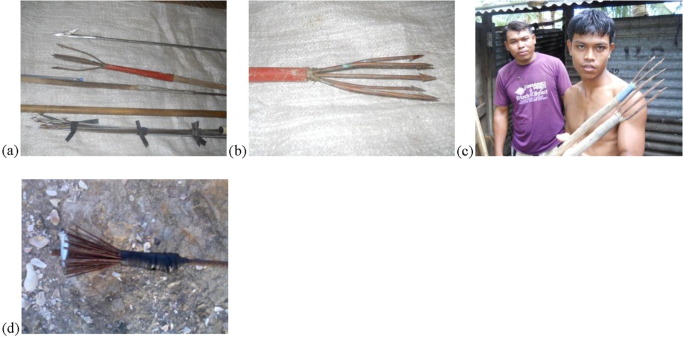
Iron rod with many prongs are also used for exploiting the fishes, which is made by tying of small sized (10 cm) thin iron needle (made by cutting of bicycle wheel bar) at one end with help of waste rubber tube and a twine, line or rope is attached to the other end. The spear is thrown on the fish shoal and then pulled. Spears are used for capturing of bait fishes and small fishes (Fig. 3d).
Lift net/scoop net
The scoop net used by the Nicobarese round in shape and it does not have a handle. It is made by bending a bamboo stick to form a scoop of about 60 cm diameter and a handmade net with smaller mesh size about 12 mm and with a webbing length of about 1 m is fixed to the bamboo frame using a twine. The scoop net is used to collect small fishes, fry and fingerlings irrespective of its species like carangids, mullets, milk fishes, crab etc. from shallow and narrow crevices or nallahs (Fig. 4).
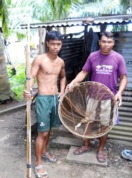
Light fishing
Night fishing by the tribal men and women at seashore during low tide is a very common sight in Car Nicobar. The fishes and octopus are caught by exploiting their phototaxic behaviour. The dried coconut leafs are folded, tied closely and are lit to use them as a light source for attracting the fishes (Fig. 5). They also use torch lights, kerosene lights or burn the cycle tyres for attracting the fishes and octopus.
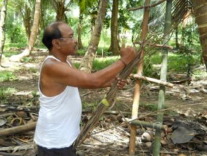
Fishing hook
The Nicobari tribes purchase the small hooks needed for capturing of fish in near shore waters from shops and local fisheries department. The bigger hooks required in hand lining and trolling for capturing bigger fishes from the high seas are generally made from thin silver rods. The silver rod is shaped into the hook by heat treatment and the barb is made by using hawk saw, rubbing tool and by repeated hammering (Fig. 6). The fishing hooks made by the tribal fisher are long with flattened shank which aids in fastening the line properly and prevents escape of fish after catching. The edge of the hook are usually made very sharp and pointed. These hooks are strong and non-corrosive and are used up to one year.
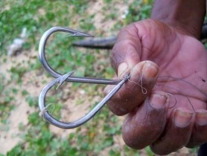
Sinkers
Nicobari tribes design their own sinkers for their fishing gears and make them using clay moulds, which is a highly skilled act. They prepare two equal portions of the clay bar to make a rectangular shaped mould. At one side of the bar the shape of the required sinker is made and in another bar the opposite notch is created. Both the bars are provided with a groove from top and side also (Fig. 7a–e). The top groove is used to aid in filling the melted lead in the notch of the bar and the side groove is used for making a hole in the sinker, which is needed for inserting the fishing line to tie with the fishing net. They make sinkers with different sizes and shapes for their own use or for selling. They get the lead sinkers from the local fisheries department and from private shops for making sinkers of different shapes using different moulds (Fig. 8). The lead or old sinker is melted in a pan, poured into the clay mould via the hole in the mould and a thin iron wire is inserted which in turn paves way for inserting the line or twine for easy tying with the net. Once it is set, the mould is detached and the sinker put in the water for cooling. These sinkers are used for cast nets, gill nets and shore seines.


In case of in hand lining, long lining and for capturing octopus conical sinkers are generally used. For making conical sinkers, the Nicobarese make a cone shaped mould in the slightly wet soil in the floor by using another cone shaped sinker/object and insert a paper folded into a cone shape. The molten lead is poured into it and a stick of required thickness is inserted immediately after that at the centre of the poured lead. After 30 min, the sinker is taken out from the indigenous mould by pulling the paper out (Fig. 9a–d). The hooks are fixed to the conical end of the sinker or at times in the flat surface of the sinkers as it is required for capturing octopus.
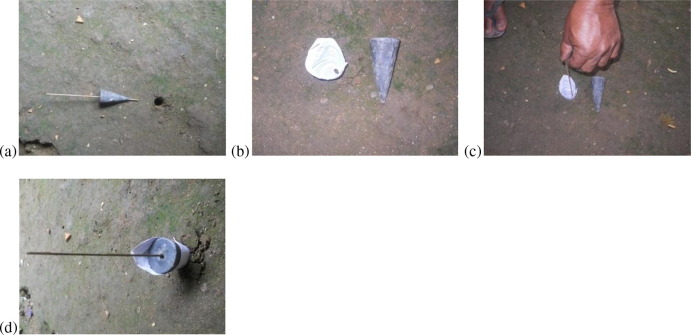
The Nicobari tribal fishers also use cylindrical sinkers made of cement in their gill nets and shore seines. In this case, they utilise waste plastic pipes and leaves of the coconut tree as a mould (Fig. 10a and b). The pipe is cut into required size (6–8 cm) and the mortar made of cement and sand (2:1 ratio) is filled into the mould. A stick, thickness of which depends on the size of the rope to be used for tying the sinker with the webbing, is inserted at the centre. It is left for a while, taken out and allowed to dry completely before use.

Snood wire
The Nicobari tribes make the snood wire, of approximately 70 cm length, for use in troll lines, long lines and hand lines with the old two wheeler brake wire. One end of the snood wire is tied with the hook and another end with the swivel in line fishing. The snood wire protects the main line from getting damaged by the fish while fishing (Fig. 11)

Baits
Nicobarese commonly use fish, hermit crab and filamentous algae as natural baits while operating hand line, long line and troll line. Hermit crabs collected from jungle and small fishes such as sardines, anchovies, carangids collected by using gillnet, cast net and multi pronged spears from the shallow areas are used as bait for carnivorous fishes (such as carangids, barracuda, sailfish, tuna, seer fish) while filamentous algae collected by hand from sea are used to capture herbivorous fishes. For capturing of carnivorous fishes the baits are used in live or fresh condition (Fig. 12a–c). Occasionally small cock feathers tied to the flattened shank of the hook using a thread and nylon line is also used as bait for capturing the fishes. Of late, the tribes also use cut pieces of plastic material, cardboard box and cloth of red colour also used as artificial bait to attract the fishes (Fig. 13a–e).


Handmade needle
Fishing net was introduced in these islands by the Malaysian and Burmese merchants (Sharief, 2008). However, the Nicobari tribes of late braid their own nets. They use single and double pointed needle made from waste plastic and bamboo for braiding new nets or for repairing old nets. The design of the needle commonly used by these tribes is unique with one edge of the single pointed needle, mostly made of waste plastic, being sharp and another edge with a fork end (Fig. 14). It is very flexible and eases entering inside the mesh while repairing or making of new fishing net. To some extent, the people are using bamboos for making of this needle. Generally for making of needle they uses very small and sharp knife.
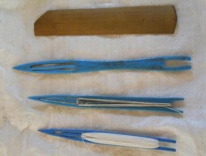
Gauge
The gauges are thin and rectangular and are made from bamboo/other woods. The edges of the gauges are shaved for smooth handling and braiding. They are used for making of uniform mesh in the webbing. Different sizes of gauges are used based on the mesh size requirement.
Fishing line winding wood
The Nicobari tribes use various flat woods for winding the fishing lines and also for hauling fishes during hand lining and trolling. They make this wooden line winding tool from locally available trees (Fig. 15), though of late, styrofoam sheets are also used for the purpose while capturing small fishes.

Fish scale remover
The Nicobarese use traditionally made scrubber for removing scales of fish. It is made of wooden piece, at one end of which 6–10 iron nails are fixed (Fig. 16). The scrubber is rubbed against the fish for removing the scales.

Dao
It is one of the very primitive tools used by the fisherwomen and men for fishing and various other tasks related to fishing. Tribal women use Dao to catch fish and crab from nallas, shallow coastal areas, rocky areas and for chopping the fishes. It is also used for making fishing crafts and requisites and cutting fishes, (Fig. 17).

Bamboo sangya
Nicobarese use strong bamboo poles of 1–3 m long for carrying fishing gears, baits, diesel, water and food for crews. This bamboo pole is carried with their ends by two of the crew members on their shoulders while the tied materials to be carried are placed to the pole in the middle. Usually bamboo is used and rarely the tribes use other round and thin wooden poles for the purpose (Fig. 18).

Bags made of damaged fishing gears
Fishermen carry their food and other fishing materials to sea in a bag made from the old or damaged fishing gear found in and around the island sea shore. They collect the waste fishing nets ashored on the beaches from the high seas. The damaged fishing nets are cut, folded and stitched at three edges, leaving open one end (Fig. 19). The Nicobarese use the bigger webbings found in the sea shore, like parts of trawl net, for tying between the trees and to rest.

Utilities from drift buoy
Due to the geographical proximity of Car Nicobar to South East Asian Countries and operation of foreign fishing vessels in Andaman seas, the island’s beaches receive lot of debris consisting of damaged fishing gears and their accessories such as float, sinkers, hooks, lines, rope, buoys, barrels, fish box, thermo coal, water cans, etc. The Nicobarese use these materials for making their improvised fishing implements. They use the drift buoy, collected from such debris, as a buoy or for carrying water or holding fishing hooks/utilities.
Snorkeling kit
The tribal fishers use indigenously made snorkeling gear for fishing in coastal waters using spears. They use new or used polyvinyl chloride (PVC) pipes, cut to required length, bend one of its ends by applying slight heat (Fig. 20) and attach an indigenously made mouth piece using rubber, which will be held by the teeth while snorkeling. The mask is made from broken or used glasses, which are shaped using hacksaw blade and covered water-tightly using strips of rubber tubes, over which a waste or new aluminium thin sheet is fixed properly to prevent entry of water.

Traditional Nicobari calendar
The tribes in Car Nicobar Island have their own calendar which is adopted from the time immemorial (Fig. 21). This calendar is mainly used for identifying the date, day and for fixing of traditional festivals such as Hodi race, pig festival and bada dhin; domestic functions like marriages; and also to elucidate fishing seasons, tides, full moon and new moon, weather patterns like rainy and summer season.

The elderly Nicobari tribes are experts in making of this calendar and make it on thin wooden pieces and nowadays they use cardboard. It specifies name of month, date, name of the day and seasons (Table 3). In order to mark and differentiate them, holes were made and to that small sticks were fixed. As their calendar clearly shows high and low tide periods, it aids in planning the sea voyage and fishing trips. The calendar is also used in agriculture for planning sowing and harvesting period.
| Season | Seasons in Nicobarese | Months |
|---|---|---|
| Summer | Sikehngo | February, March, April |
| Heavy rain (south west monsoon) | Sung | May, June, July |
| Moderate rain | Iluoi | August, September, October |
| Windy season (north east monsoon) | Chuhot | November, December, January |
Wind direction finder
The Nicobari tribes use an indigenously designed gadget in the shape of an aeroplane or cross bar made from the scrap materials viz., bicycle wheel hub, wood, plastic. It rotates smoothly and stays parallel to the direction of wind flow. The direction finder is fixed at the top of the bamboo pole of about 3 m height, which in turn is fixed in the ground in an open place for knowing proper wind direction (Fig. 22). The Nicobari tribes traditionally use this information for deciding on their time and course of fishing.

Conclusion
Fishing is intrinsically twined to the lives of Nicobari tribes. Day-to-day necessities and requirements of life drive men to innovate and search for new things urging them to think differently and the tribes are no exception to this. They have acquired their fishing and navigational skills from their fore-fathers while the contemporary knowledge on the fishing methods have helped them improvise many implements using locally available materials. Due to techno, infra constraints and lack of interest among the tribal youths the traditional knowledge gained over many years vanishing deliberately. Moreover, the traditional knowledge of the tribes inhabiting Car Nicobar island related to fishing is giving way to modern methods of fishing.
Being Car Nicobar Island located in the Bay of Bengal (BOB). BOB is believed to be a biological hotspot of the marine ecology in the world hence conserving and encouraging the sustainable conventional fishing practices is much essential for the uphold of biological productivity (Rathakrishnan et al., 2009). Hence, it is essential to document the traditional practices before vanishing. It is also very much important in order to sustain the fisheries in this island in the long run without affecting the marine environment and bio diversity.
Acknowledgments
The Authors express their sincere thanks to The Director, CARI, Indian Council of Agricultural Research units, Port Blair for the extension of facility during this study.
References
- Adikant et al., 2011 P. Adikant, S.K. Nag, S.K. Patil Traditional fishing techniques of tribes in Bastar region of Chhattisgarh. Indian J. Tradit. Knowl., 10 (2) (2011), pp. 386-387
- Anon., 2012 Anon.Andaman and Nicobar Islands – Fisheries at a Glance – 2011. Department of Fisheries, Andaman and Nicobar (A&N) Administration, Port Blair (2012), p. 16
- Chauhan et al., 2004 N. Chauhan, H. Padalia, S. Gupta, M.C. Porwal, P.S. Roy Nicobari tribe of the Car Nicobar Island: keeping in pace with time. J. Hum. Ecol., 16 (3) (2004), pp. 155-161
- Dutta and Bhattacharjya, 2008 R. Dutta, B.K. Bhattacharjya An indigenous community fishing practice of Tirap district, Arunachal Pradesh. Indian J. Tradit. Knowl., 7 (4) (2008), pp. 624-626
- Gupta et al., 2004 S. Gupta, M.C. Portwal, P.S. Roy Indigenous knowledge on some medicinal plants among the Nicobari Tribes of Car Nicobar Island. Indian J. Tradit. Knowl., 3 (3) (2004), pp. 287-293
- Gurumayum and Choudhury, 2009 S.D. Gurumayum, M. Choudhury Fishing methods in Northeast India. Indian J. Tradit. Knowl., 8 (2) (2009), pp. 237-241
- Kalita et al., 2010 B. Kalita, A. Dutta, S.K. Bhagabati, A. Sharma Indigenous technical knowledge for fish harvesting in Karbi-Anlong district of Assam. Indian J. Tradit. Knowl., 9 (2) (2010), pp. 252-255
- Manna-Ranjan et al., 2011 K. Manna-Ranjan, K. Das-Archan, D.S. Krishna-Rao, M. Karthikeyan, D.N. Singh Fishing craft and gear in river Krishna. Indian J. Tradit. Knowl., 10 (3) (2011), pp. 491-497
- Rathakrishnan et al., 2009 T. Rathakrishnan, M. Ramasubramanian, N. Anandaraja, N. Suganthi, S. Anitha Traditional fishing practices followed by fisher folks of Tamil Nadu. Indian J. Tradit. Knowl., 8 (4) (2009), pp. 543-547
- Sharief, 2008 M.U. Sharief Tribal artifacts of Nicobari folk of Nicobar Archipelago. Indian J. Tradit. Knowl., 7 (1) (2008), pp. 42-49
- Tynsong and Tiwari, 2008 H. Tynsong, B.K. Tiwari Traditional knowledge associated with fish harvesting practices of War Khasi community of Meghalaya. Indian J. Tradit. Knowl., 7 (4) (2008), pp. 618-623
- Ulman et al., 2008 Y.N. Ulman, V.G. Naik, J.M. Talathi Traditional fishing practices and socio cultural activities of Koli community in the Konkan region of India. Asian Agri Hist., 12 (4) (2008), pp. 311-319
- Verma et al., 2010 C. Verma, S. Bhatia, S. Srivastava Traditional medicine of Nicobarese. Indian J. Tradit. Knowl., 9 (4) (2010), pp. 779-785
- Victor-Rajamanickam, 1997 G. Victor-Rajamanickam Traditional sea knowledge prevailing among tribes of Andaman and Nicobar Islands. Indian J. Hist. Sci., 32 (1) (1997), pp. 29-46
- Zamir Ahmed et al., 2013 S.K. Zamir Ahmed, T. Ravikumar, P. Krishnan, S. Jeyakumar Traditional fishing crafts and gears used by the Nicobari tribes in Car Nicobar. Indian J. Tradit. Knowl., 12 (1) (2013), pp. 144-148
